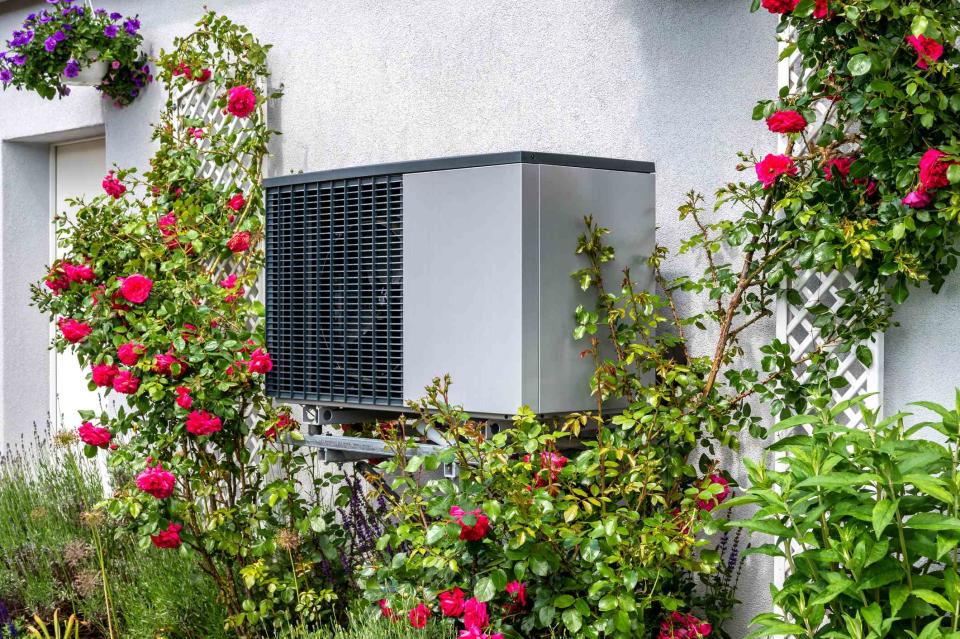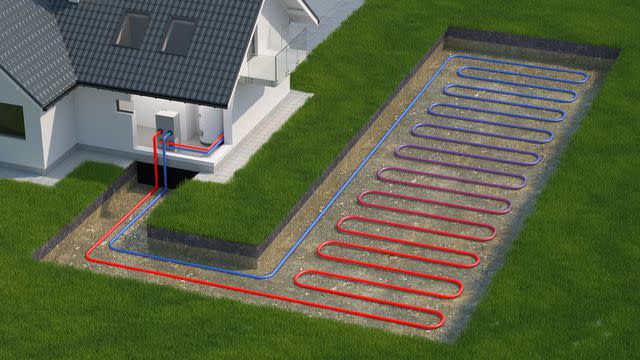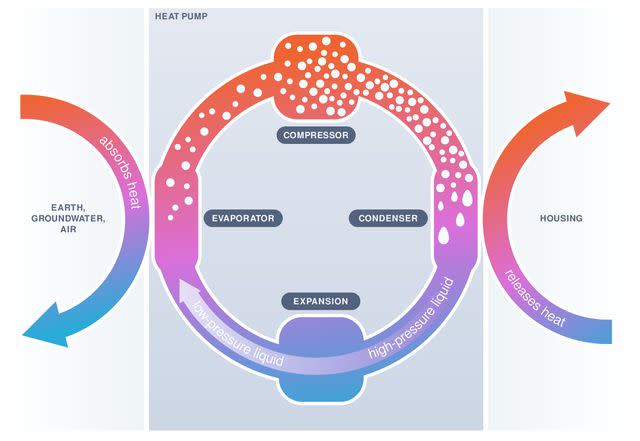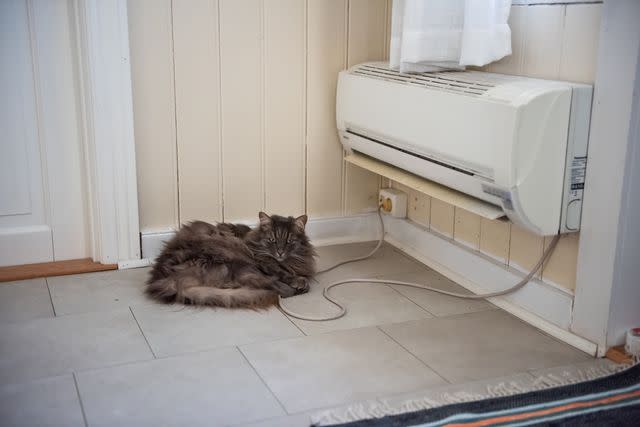What Is a Heat Pump? How Does It Work?
A heat pump is an efficient, sustainable way to heat and cool your home.

Ralf Geithe / Getty Images
Fact checked by Olivia Young
Heat pumps function similarly to refrigerators or air conditioners, which take warm air from one space and send it to another. In the winter, a heat pump transfers heat from the outdoors inside and, in the summer, it reverses this process.
As average global temperatures continue to rise, demand for air conditioning is expected to nearly quadruple by 2050, compounding the climate crisis. Using heat pumps instead can make a significant dent in the greenhouse gas emissions (GHG) of buildings. In this article, we discuss how heat pumps are the more sustainable option, as well as other buyer benefits, costs, and buying tips.
How Heat Pumps Work
There are two main types of heat pumps, and both can function as space heaters or coolers and water heaters.
Ground-Source Heat Pumps

KangeStudio / Getty Images
Schematic of a ground-source heat pump.A ground-source (or “geothermal”) heat pump sends a mixture of water, antifreeze, and/or a refrigerant through a network of pipes buried below the frost line. As the liquid passes through the pipes, it acts as a heat exchanger, absorbing Earth’s heat. The liquid is then drawn up into a compressor, which heats it further, creating a vapor. A fan in the heat pump then distributes the warm air through ducts or tubes throughout a building.
In the summer, a ground-source heat pump reverses the process, taking the warm air out of the house and storing it in the soil.
What Is a Heat Exchanger?
A heat exchanger is any device that transfers heat from one fluid to another without mixing the fluids.
Air-Source Heat Pumps

Onidji / Getty Images
A heat pump's inner workings.An air-source heat pump extracts heat from the air rather than from the ground. A fan in an outdoor unit sucks air from the atmosphere and passes it over heat-exchanging coils that contain a liquid refrigerant with an extremely low boiling point.
As the refrigerant boils, it is fed through a compressor, which heats it further. The compressed vapor then passes through a similar coil in the indoor unit, heating it up. A fan then releases the refrigerant’s heat into the air and circulates it through the house.
As the refrigerant cools, it passes through an expander (the opposite of a compressor) and returns to its liquid state. The refrigerant is then sent into the outdoor coil to start the process all over again.
As with a ground-source heat pump, a reversing valve inside the heat pump allows the same process to act as an air conditioner in the summer.
Do Heat Pumps Work in Cold Climates?
Ground-source heat pumps are not affected by atmospheric temperature variations, since the ground below the frost line remains relatively stable. Not too long ago, air-source heat pumps were not efficient enough to work in extremely cold climates. But today, there are heat pumps in Antarctica, northern Canada, and northern Europe. The refrigerant in an air-source heat pump can be between -15 and -56 degrees F. Any air above the temperature of the refrigerant will turn it into a vapor.
Air-source heat pumps need to work harder (and thus use more electricity) to extract heat from extremely cold air. Still, high-performance heat pumps are twice as efficient as natural gas heating systems in sub-zero temperatures.
Sustainability of Heat Pumps
More than half of all energy use in residences and commercial buildings goes toward space heating/cooling and water heating. That’s why commercial and residential buildings contribute 34% of global greenhouse gas (GHG) emissions, including 13% of all U.S. GHG emissions.
How heat pumps are able to lower these emission numbers depends on many factors, including the source of the electricity used to run the heat pumps. In 2021, 40% of U.S. electricity came from non-fossil fuel sources, so in much of the U.S., an electric heat pump will be cleaner than burning fossil fuels in your basement. Safer, too: between 2010 and 2015, 2,244 Americans died from unintentional carbon monoxide (CO) poisoning, which results from the incomplete burning of fossil fuels. Most CO deaths occur in winter.
Use your own rooftop solar panels to run your heat pump, and you have nearly eliminated the GHG and potential carbon monoxide emissions created to heat and cool your house.
Costs and Efficiency
Purchasing a heat pump can be more cost-effective than purchasing both a gas furnace and an air conditioning system.
The home improvement company Modernize estimates the average upfront cost of an air-source heat pump to be between $3,500 and $5,200, with some costing more than $1,800 depending on the complexity of the installation. Furnace Price Guides says the average cost for a gas furnace is $3,980, with a range of $1,690 for a basic furnace (before installation) to $6,910 for the installation of a high-efficiency model.
The upfront cost of a ground-source heat pump can be much higher—from $10,000 to $30,000 for most systems—given the digging and piping that need to be done.
Keep in mind that heat pumps replace not just heating systems but cooling systems as well—you're getting a two-in-one deal, with the potential to save thousands of dollars. (The national average for a new central air conditioning system is roughly $5,600, plus installation.)
Energy Efficiency
Air-source heat pumps are able to “deliver up to three times more heat energy to a home than the electrical energy it consumes” depending on the region, according to the U.S. Department of Energy. This can be more than triple the efficiency of a new natural gas furnace, the most efficient of all fossil-fuel-based furnaces. (An older furnace can be as little as half as efficient as a new one.) Ground-source heat pumps are even more efficient, reducing energy consumption by 44% compared to air-source heat pumps.

Trygve Finkelsen / Getty Images
Operating Costs
Because of their increased efficiency, the annual running cost of a heat pump is almost always lower than that of a gas furnace—depending on the heating requirements of the home, the price of electricity, and the price of natural gas.
In all but four states (Alaska, Hawaii, Michigan, and New Mexico), it costs less to heat a home with an air-source heat pump than with a high-efficiency gas furnace. In the state with the most drastic cost differential (Maine), the 15-year savings of a heat pump over a gas furnace was more than $13,000. That's the price of your next heating system.
While the efficiency and operating cost of a heat pump and a central air conditioning unit are comparable, the operating costs of a window air conditioner tend to be higher when used to cool several rooms in a house.
Stable Energy Costs
Air conditioners and HVAC systems are the most electricity-demanding appliances in your home, accounting for 12% of average U.S. home energy expenditures. (In the South, that amount can rise to 27%.) With the ongoing rise of average temperatures due to climate change, those expenses are only going to go up. Running on electricity, heat pumps can help keep those cost rises to a minimum.
Fossil fuel costs—the main driver of inflation—are historically much more volatile than electricity costs, which are often subject to state public utility regulation. (Of course, in markets where electricity is generated using fossil fuels, the two costs are related.) As noted above, the U.S. electrical grid is already 40% run on non-fossil sources. As more lower-cost and price-stable renewable energy enters the American grid, the economic benefits of electric heat pumps will be increasingly clear, allowing American consumers and businesses to count on stable heating and cooling costs at a time when their home energy needs may be rising.
Financial Incentives
Federal and state incentives can reduce the cost of heat pumps even further. The 2022 Inflation Reduction Act includes tax credits for the purchase and installation of a heat pump up to $2,000. You can also look for state and local government incentives available in your area. Your local electric utility may also offer incentives to switch.
Heat Pump Purchasing Tips
Get an energy audit first. Why waste money heating a drafty home?
Make sure your pump has been properly sized for your home, just as you would for an air conditioner.
Consider noise factor. Most heat pumps are super quiet, especially indoors. Compare the rated decibel levels in the product literature before making any purchase or signing any contract.
Consider maintenance and warranties. Like any heating/cooling system, heat pumps don’t last forever—on average, 10 to 15 years. Annual maintenance will extend their life.
Make sure your home has the electrical service capable of running a heat pump. Older homes may need an electrical upgrade to support the amperage required to run a heat pump, which will add costs to your system.
The best time to buy a heat pump is when your current HVAC system needs replacing or when you are building a new home.
Frequently Asked Questions
Can heat pumps work on homes without air ducts?
Yes. “Ductless” heat pumps are used to retrofit homes without air ducts. An indoor air handler is connected to the outdoor unit via conduits and then distributes the air inside the house.
Do the refrigerants in heat pumps deplete the ozone layer?
The ozone depletion potential depends on the type of refrigerant. Refrigerants containing chlorofluorocarbons have been phased out since the signing of the Montreal Protocol in 1987, and in 1992 hydrochlorofluorocarbons were added to the list. Hydrocarbons such as propane and isobutane have much less global warming potential and, thus, are the more sustainable refrigerant options.

